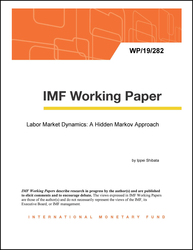
Labor Market Dynamics: A Hidden Markov Approach
This paper proposes a hidden state Markov model (HMM) that incorporates workers’ unobserved labor market attachment into the analysis of labor market dynamics. Unlike previous literature, which typically assumes that a worker’s observed labor force status follows a first-order Markov process, the proposed HMM allows workers with the same labor force status to have different history-dependent transition probabilities. I show that the estimated HMM generates labor market transition probabilities that match those observed in the data, while the first-order Markov model (FOM) and its many-state extensions cannot. Even compared with the extended FOM, the HMM improves the fit of the empirical transition probabilities by a factor of 30. I apply the HMM to (1) calculate the long-run consequences of separation from stable employment, (2) study evolutions of employment stability across different demographic groups over the past several decades, (3) compare the dynamics of labor market flows during the Great Recession to those during the 1981 recession, and (4) highlight the importance of looking beyond distributions of current labor force status.
Publication date: December 2019
ISBN: 9781513519265
$18.00
Add to Cart by clicking price of the language and format you'd like to purchase
Available Languages and Formats
| English |
Prices in red indicate formats that are not yet available but are forthcoming.
Topics covered in this book
This title contains information about the following subjects.
Click on a subject if you would like to see other titles with the same subjects.
Unemployment Business Cycle , Unemployment , Great Recession , WP , FOM , transition probability , nonparticipant , mean absolute deviation
Summary
Copyright © 2010 - 2024
Powered by:
AIDC



